Interesting Facts About Donatello You Never Knew
You might think you know Donatello, but there's more to this Renaissance master than meets the eye. Born to a wool carder, he started as a goldsmith's apprentice before joining Lorenzo Ghiberti's workshop. Donatello pioneered groundbreaking techniques like schiacciato and figura serpentinata, revolutionizing sculpture. His Bronze David stirred controversy for its sensual portrayal, while his gaunt Mary Magdalene challenged beauty norms. The Medici family's patronage propelled his career, resulting in masterpieces like the Gattamelata equestrian statue. Even his unfinished works, like the Pulpits of San Lorenzo, left a lasting impact on future artists. Donatello's innovations continue to shape the art world today. Uncover the depths of his artistic genius and you'll gain a new appreciation for this Renaissance legend.
This post may contain affiliate links. If you make a purchase through these links, I may earn a commission at no additional cost to you. Additionally, portions of this post may be generated using artificial intelligence (AI) technology. While we strive for accuracy, please be aware that AI-generated content may not always be perfect and should be fact-checked when necessary.
The Spatula Scoops
- Donatello created the first life-sized free-standing nude sculpture since antiquity, revolutionizing Renaissance art.
- He pioneered the schiacciato technique, allowing for atmospheric perspective in low-relief sculptures.
- Donatello's unconventional portrayal of Mary Magdalene as gaunt and disheveled challenged idealized religious imagery.
- His bronze David statue sparked controversy for its sensual depiction, challenging traditional biblical representations.
- Donatello's final major project, the Pulpits of San Lorenzo, was left unfinished but still influenced future generations of sculptors.
The Wool Carder's Son
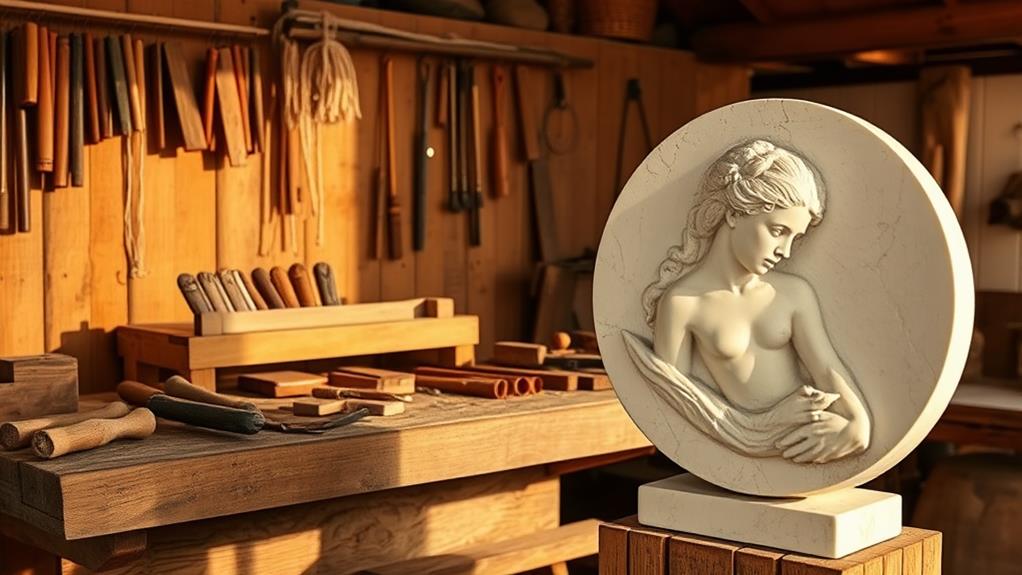
A humble beginning shaped the life of one of the Renaissance's greatest sculptors. You might not know that Donatello, born Donato di Niccolò di Betto Bardi, was the son of a wool carder in Florence. His father's modest profession in the bourgeois society provided a stable upbringing, setting the stage for Donatello's artistic journey.
Growing up in Florence, a hub of cultural innovation, young Donatello was surrounded by classical art and creativity. This environment sparked his artistic passion. Despite his humble beginnings, he managed to secure artistic training, first in a goldsmith workshop. His talent caught the eye of Lorenzo Ghiberti, who welcomed him into his prestigious workshop. It was here that Donatello honed his sculpture skills, laying the foundation for his future innovations.
Donatello's rise from the son of Niccolò di Betto Bardi to a renowned Renaissance sculptor is a reflection of his exceptional talent and determination. His humble origins didn't hinder his artistic development; instead, they fueled his drive to excel in sculpture, ultimately revolutionizing the art world with his innovative techniques and expressive style.
Ghiberti's Apprentice
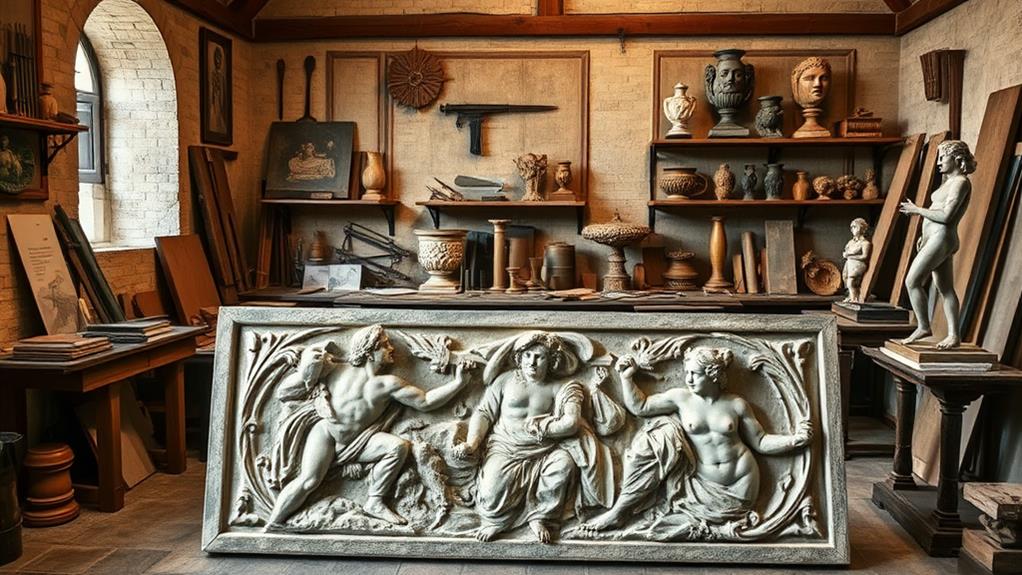
You'll find Donatello's early workshop experience began in 1404 when he joined Lorenzo Ghiberti's workshop as an apprentice. During this formative period, you'd see Donatello developing essential skills in sculpture and relief carving, while being exposed to early Renaissance techniques and the importance of naturalism. This influential mentor relationship with Ghiberti, a master in bronze casting and relief sculpture, would shape Donatello's artistic direction and approach to detailing, setting the foundation for his unique style and innovative techniques.
Early Workshop Experience
Donatello's artistic journey began in earnest around 1404 when he entered Lorenzo Ghiberti's workshop as an apprentice. This experience proved pivotal in shaping his future as a renowned sculptor. During his time with Ghiberti, Donatello honed his skills in sculpting and relief work, gaining exposure to the early Renaissance style that would define his later masterpieces.
In Ghiberti's workshop, you'd have found Donatello immersed in studying classical sculpture and techniques. This immersion helped him develop a deep understanding of the human figure and principles of design. The influence of his apprenticeship is evident in his first notable work, a marble statue of David, which showcases the stylistic elements he learned during this formative period.
| Skill | Influence | Outcome |
|---|---|---|
| Sculpting | Classical techniques | Mastery of form |
| Relief work | Early Renaissance style | Depth in compositions |
| Figure study | Human anatomy | Lifelike representations |
Donatello's time as Ghiberti's apprentice laid the foundation for his distinct style, characterized by emotional expression and a profound understanding of form. This early workshop experience was instrumental in his evolution from Gothic to Renaissance art, setting the stage for his future innovations in sculpture.
Influential Mentor Relationship
Lorenzo Ghiberti's mentorship of Donatello from 1404 to 1407 proved to be a defining factor in the young artist's career. During his apprenticeship, Donatello gained foundational skills in sculpting and was exposed to the emerging Renaissance style. You'll find that Ghiberti's influence shaped Donatello's early works, particularly in techniques related to relief carving and the depiction of human figures.
This mentorship instilled in Donatello an appreciation for classical aesthetics, which became a hallmark of his later innovations in sculpture. You might be interested to know that Donatello's first major statue, David, was created as a stylistic homage to Ghiberti's works. This highlights the significance of his apprenticeship in his artistic development.
The relationship with Ghiberti marked the beginning of Donatello's exploration of narrative and emotional expression in sculpture. This experience paved the way for his influential career, setting the stage for his future contributions to Renaissance art. As you can see, Ghiberti's guidance was instrumental in shaping Donatello's approach to sculpting, providing him with the skills and inspiration needed to become one of the most renowned artists of his time.
Donatello's Groundbreaking Techniques
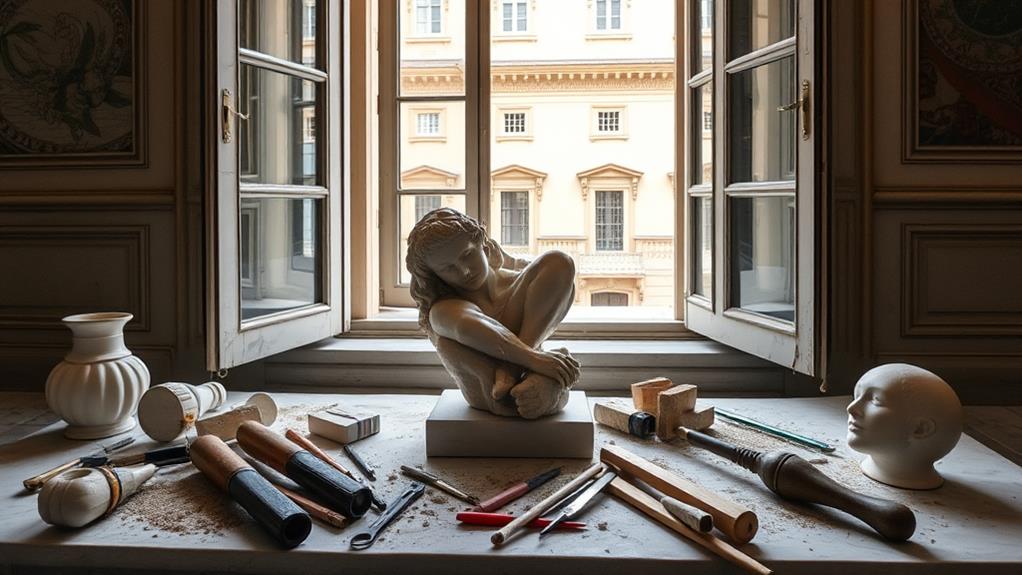
Several groundbreaking techniques revolutionized Renaissance sculpture through Donatello's innovative approach. You'll be amazed at how he transformed the art world with his mastery of:
- Schiacciato technique
- Figura serpentinata
- Chiaroscuro
Donatello pioneered the schiacciato technique, using shallow relief carving to create atmospheric perspective and enhance storytelling in his sculptures. He introduced figura serpentinata, giving figures a sense of movement and dynamism similar to the classical contrapposto stance. His mastery of chiaroscuro allowed him to use light and shadow effectively, adding depth and emotional expression to his sculpted forms.
You might not know that Donatello was the first to create a life-sized free-standing nude sculpture since antiquity. His bronze David marked a significant shift towards realism in Renaissance art. He developed a nuanced approach to anatomical accuracy, focusing on individualized, expressive figures that conveyed human emotions. This was a departure from the more rigid forms of Gothic sculpture.
Donatello's groundbreaking techniques set him apart from his contemporaries and influenced generations of artists to come. His innovations in sculpture continue to be studied and admired today, cementing his place as a true master of Renaissance art.
The Bronze David's Controversy
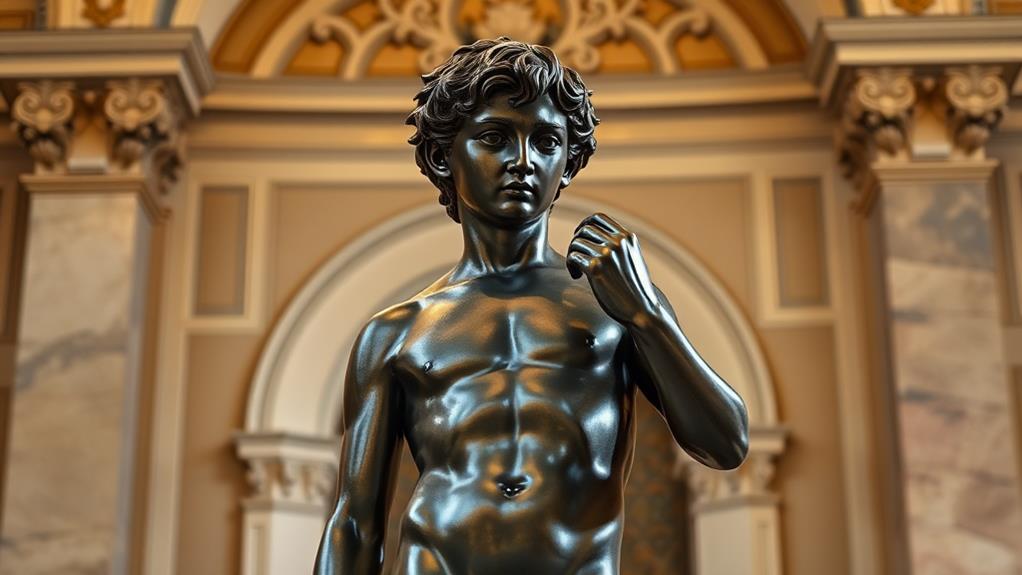
You might be surprised to learn that Donatello's bronze David stirred up quite a controversy in its time. The sculpture's nudity and sensual pose challenged traditional depictions of biblical figures, leading to discussions about masculinity and identity during the Renaissance. Additionally, the Medici family's commissioning and public display of such a provocative piece raised eyebrows, highlighting the complex relationship between art, politics, and societal norms in 15th-century Florence.
Nudity and Homosexual Undertones
Examining Donatello's bronze David statue reveals a groundbreaking work that sparked controversy in Renaissance Italy. This free-standing sculpture challenged societal norms with its bold display of nudity, pushing boundaries in artistic expression. You'll notice the statue's intimate portrayal of David, which some interpret as having homosexual undertones.
Here are three key aspects of the statue that contribute to its controversial nature:
- David's relaxed contrapposto pose
- The positioning of his hand on Goliath's severed head
- The juxtaposition of masculine and feminine features
The statue's sensual beauty and youthful form reflect larger discussions about masculinity and sexuality during the Renaissance. Art historians have speculated on Donatello's personal views, considering the Medici court culture's influence on his work. The statue's portrayal of David's vulnerability and strength simultaneously challenges traditional notions of masculinity.
Medici Family Controversy
The bronze David's controversy extends beyond its artistic merits, intertwining with the political landscape of Renaissance Florence. Donatello's masterpiece, commissioned by Cosimo de' Medici, wasn't just an artistic achievement; it was a calculated political statement. You might not know that the Medici family used this sculpture to assert their power and cultural influence in Florence.
The statue's placement in the Medici palace garden was deliberate, connecting the family to the biblical narrative of David overcoming Goliath. This symbolism wasn't lost on the Florentine artistic community, who saw it as a bold move by the Medicis to position themselves as cultural patrons.
However, the bronze David's homoerotic undertones and nudity sparked controversy. Some praised its artistry, while others criticized its daring interpretation. This mixed reception didn't deter the Medici family from using it to their advantage. By embracing such a provocative work, they established themselves as progressive and influential patrons of the arts.
The controversy surrounding Donatello's bronze David ultimately served to cement the Medici family's dominance in Florence's cultural sphere, shaping the artistic landscape of the Renaissance.
Unconventional Mary Magdalene
Innovation characterizes Donatello's sculpture of Mary Magdalene, created around 1455-1460. This unconventional portrayal deviates from traditional depictions, emphasizing realism and emotional depth over idealized beauty. You'll notice the saint's gaunt features and disheveled hair, reflecting her suffering and spiritual transformation.
Donatello's masterful wood carving techniques bring this figure to life, showcasing:
- Intense expression capturing complex human emotions
- Detailed texture enhancing the sorrowful demeanor
- Remnants of original polychromy highlighting the passage of time
The sculpture's lifelike quality stems from Donatello's focus on Mary Magdalene's state of penance. He's carved her in a way that conveys her inner turmoil and spiritual journey. You'll be struck by the intense expression, which communicates themes of repentance and spirituality.
Originally, the statue was polychromed, adding to its realistic appearance. Today, only traces of color remain, serving as evidence of the sculpture's enduring message. Donatello's unconventional approach to this religious figure demonstrates his ability to push artistic boundaries while maintaining a profound connection to spiritual themes.
Equestrian Statue in Padua
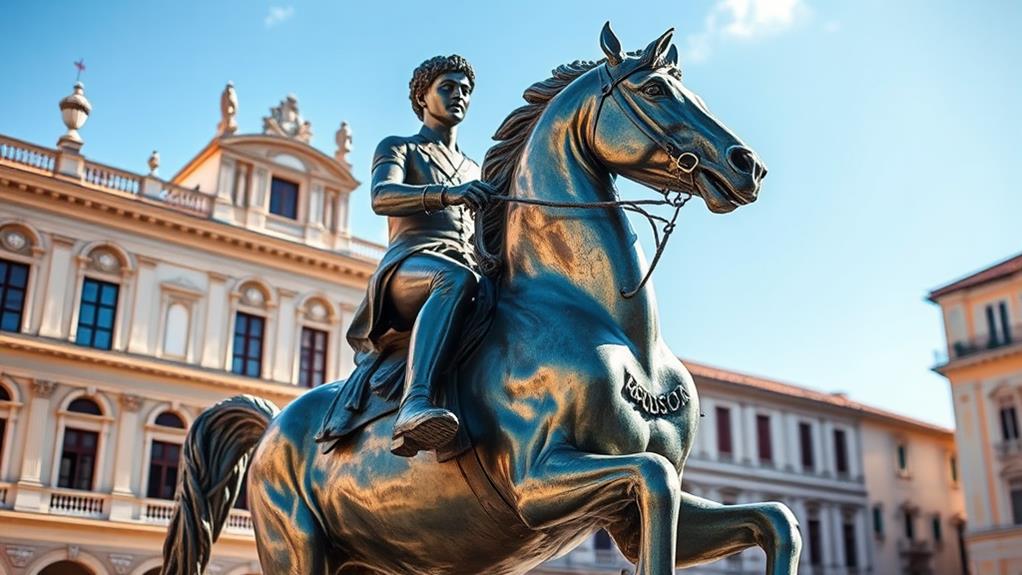
Donatello's Equestrian Statue of Gattamelata stands as a groundbreaking masterpiece in Renaissance art. You'll find this impressive bronze statue in Padua's Piazza del Santo, where it's been since its creation between 1445 and 1450. As the first major equestrian bronze statue since antiquity, it set a new standard for portraying military leaders.
When you look at the statue, you'll notice Gattamelata wearing armor and holding a baton, symbolizing his military power. Donatello's attention to anatomical details and dynamic positioning is remarkable. The sculptor's innovative use of space and perspective elevates this work, making it a pivotal piece in Renaissance art.
You can't miss the imposing pedestal adorned with reliefs, which enhances the statue's visual impact and establishes Gattamelata's heroic stature. This combination of elements showcases Donatello's skill in creating a monumental work that broke away from traditional portrayals of rulers.
As you admire this masterpiece, remember that it's not just a statue but a reflection of Donatello's artistry and his influence on Renaissance sculpture.
Medici Family Patronage
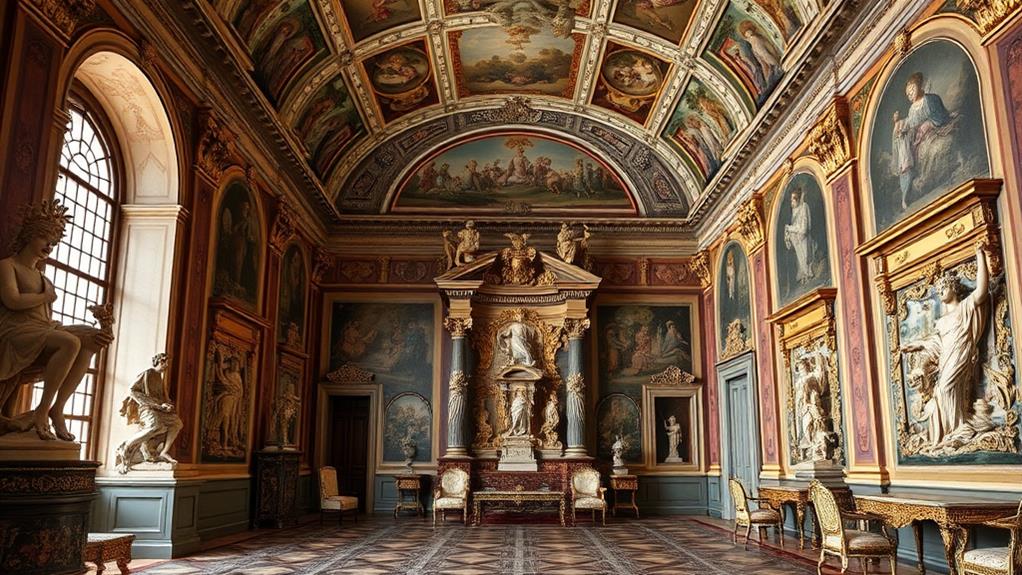
Medici family's patronage played a pivotal role in Donatello's artistic career. You might not know that this influential Florentine family provided the renowned Renaissance sculptor with numerous commissions, enabling him to create some of his most iconic works. Under their protection, Donatello flourished as a master sculptor, pushing the boundaries of artistic representation in Renaissance Italy.
The Medici's support for Donatello resulted in:
- The creation of the famous bronze David for the Medici palace garden
- Elevated status and recognition as a leading sculptor in Florence
- Opportunities to work on significant projects like the Cantoria for Florence Cathedral
Cosimo de' Medici, in particular, commissioned Donatello to produce the bronze David, marking a turning point in the depiction of human figures in Renaissance art. This patronage allowed Donatello to experiment with innovative techniques and create sculptures that captured the Medici family's desire for artistic representation of power and prestige. The relationship between Donatello and the Medici family was mutually beneficial, resulting in a legacy that intertwined his artistry with their influence, shaping the course of Renaissance art history.
Unfinished Pulpits of San Lorenzo

While the Medici family's patronage propelled Donatello to artistic heights, his final major project remains a tribute to his enduring vision and skill. You might be surprised to learn that Donatello's last masterpiece, the unfinished pulpits of San Lorenzo in Florence, showcases his sculptural mastery even in its incomplete state.
These bronze pulpits, designed for the Basilica of San Lorenzo, were meant to be Donatello's crowning achievement. He began work on them in the 1450s, but they remained unfinished when he died in 1466. The pulpits feature intricate narratives and were intended to integrate seamlessly with the architectural space of the basilica. Donatello's design aimed to exemplify both artistic skill and emotional depth, intertwining religious themes with powerful storytelling.
Despite being incomplete, these pulpits have had a lasting influence on future generations of sculptors. They highlight Donatello's innovative approach to form and narrative in sculpture. As you explore Donatello's works, you'll find that these unfinished pulpits stand as a demonstration of his evolving artistic vision and his ability to push the boundaries of sculptural art.
What Parallels Can Be Drawn Between Donatello and Daniel Boone in Terms of Legacy?
Donatello and Daniel Boone, while from vastly different realms, both left lasting legacies rooted in innovation and influence. Donatello redefined art during the Renaissance, while Boone opened frontiers that shaped American history. For those exploring these figures, interesting facts about daniel boone’s life reveal his groundbreaking role in pioneering the American wilderness.
Donatello's Lasting Renaissance Legacy
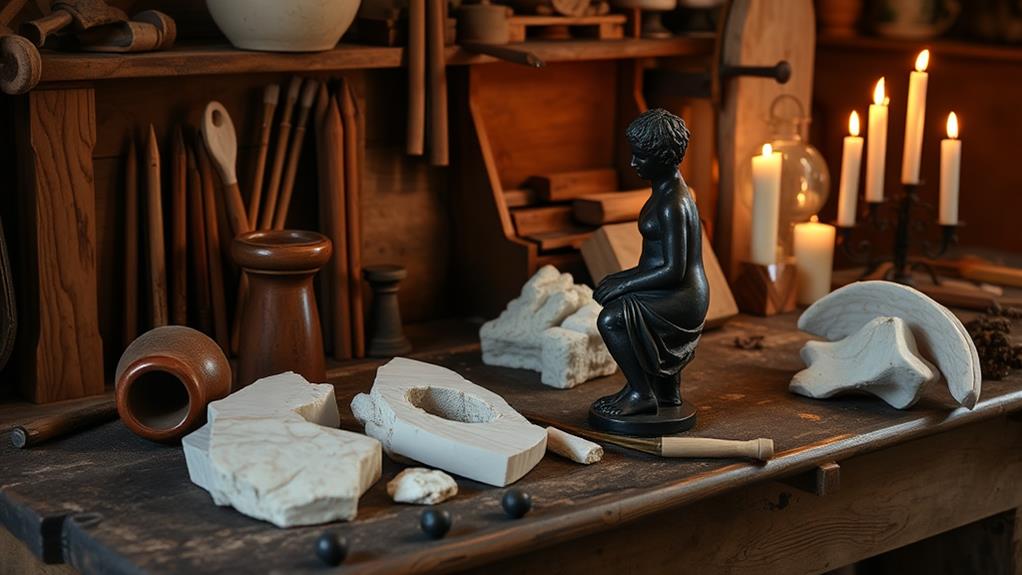
Long after his death, Donatello's innovative techniques and artistic vision continue to shape the world of sculpture. His masterpieces, characterized by emotional expressiveness and a unique blend of classical ideals with realism, have left an indelible mark on Renaissance art and beyond. You'll find Donatello's influence in:
- The schiacciato technique, revolutionizing low relief sculpture
- The first large-scale free-standing nude statue since antiquity
- The union of classical ideals with emotional realism in sculpture
Donatello's collaborations with other Renaissance greats, like Lorenzo Ghiberti and Filippo Brunelleschi, enhanced his artistic development. This resulted in a distinctive style that profoundly impacted 15th-century art. His innovations in sculpture, particularly in depicting human figures and creating depth in low relief, set new standards for future artists.
You can see Donatello's legacy in the works of Michelangelo and Raphael, who were deeply influenced by his emotional expressiveness and individualism. His pioneering techniques and artistic vision continue to inspire sculptors today, cementing his place as a pivotal figure in art history. Donatello's contributions to Renaissance sculpture remain a hallmark of his enduring influence on Western art.
Frequently Asked Questions
What Are Some Fun Facts About Donatello?
You might think Donatello's just a turtle with a purple mask, but he's actually a Renaissance master. Born in Florence, he pioneered the "schiacciato" technique for shallow relief sculptures. His bronze David was groundbreaking, being the first large-scale nude male statue since ancient times. Donatello worked with various materials, including marble and wood. He's known for emotionally charged works and innovative storytelling through sculpture. Today, he's even immortalized in pop culture through the Ninja Turtles franchise.
What Are Some Fun Facts About Donatello's David?
You might be surprised to learn that Donatello's David was groundbreaking in its time. It's the first large-scale free-standing nude sculpture since antiquity, marking a significant shift in Renaissance art. The bronze figure stands about 5 feet tall and features an unusual sword placement on Goliath's head. Commissioned by Cosimo de' Medici, it initially adorned the Medici palace garden before becoming a symbol of Florentine freedom in the Palazzo della Signoria. Its sensuous appearance sparked discussions about sexuality in art.
What Was Donatello Real Name?
Donatello's real name was Donato di Niccolò di Betto Bardi. You'll find that his full name reflects his Florentine heritage and lineage. Born around 1386 in Florence, Italy, Donatello came from a family involved in the wool trade. The name "Donatello" you're familiar with is actually a diminutive form of "Donato," which was common during that period. It's this shortened version that became associated with his groundbreaking Renaissance sculptures and has endured through history.
How Many Statues Did Donatello Make?
Can you imagine the impact of Donatello's artistic genius? While the exact number of statues he created isn't definitively known, you'll be amazed to learn that he produced over 40 major works throughout his career. These include his famous David sculptures, the five statues for Florence Cathedral, and the groundbreaking bronze equestrian statue of Gattamelata. Don't forget his numerous relief works, like the panels for the Baptistery of Florence. Donatello's prolific output truly shaped Renaissance sculpture.





